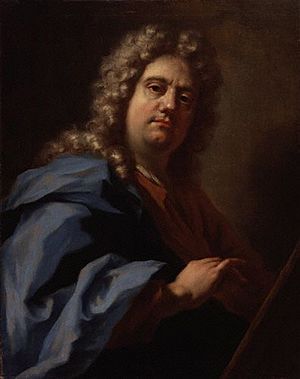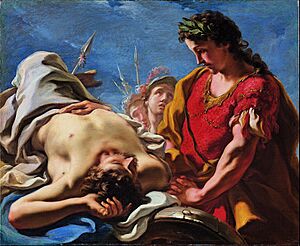Giovanni Antonio Pellegrini facts for kids
Giovanni Antonio Pellegrini (born April 29, 1675 – died November 2, 1741) was a famous Italian painter from Venice. He was one of the top "history painters" of the early 1700s. History painting means creating large artworks that tell stories, often from history, myths, or the Bible.
Pellegrini's painting style mixed ideas from older art movements. He combined the grand style of the Renaissance artist Paolo Veronese with the dramatic flair of Baroque painters like Pietro da Cortona and Luca Giordano. He traveled a lot for his work, visiting countries like England, the Netherlands, Germany, Austria, and France. Many people see him as an important artist who came before the even more famous Giovanni Battista Tiepolo. One of his students was Antonio Visentini.
Pellegrini's Early Life and Training
Giovanni Antonio Pellegrini was born in Venice, Italy. His father, also named Antonio, was a shoemaker. Young Pellegrini became a student of a painter from Milan named Paolo Pagani.
In 1690, Pellegrini traveled with his teacher to Moravia and Vienna. He returned to Venice in 1696. This is where he painted his first artworks that we still have today. Another Venetian painter, Sebastiano Ricci, greatly influenced Pellegrini's art. From 1699 to 1701, Pellegrini lived in Rome. Around 1704, he married Angela Carriera, who was the sister of the famous artist Rosalba Carriera. In 1709, Pellegrini decorated the dome above the staircase at the Scuola Grande di San Rocco in Venice.
Working in England
From 1708 to 1713, Pellegrini visited England. He was invited by the Earl of Manchester. Pellegrini became very successful there. He painted large murals in many grand English country houses.
Some of these places included:
- Kimbolton Castle for the Earl of Manchester.
- Castle Howard, though most of his work there was sadly destroyed by a fire in 1940.
- Narford Hall in Norfolk for Sir Andrew Fontaine.
An art expert named Michael Levey described Pellegrini's paintings at Kimbolton Castle. He said that even though they were painted directly onto the wall with oil paints, they looked as light and spontaneous as fresco paintings. In London, Pellegrini also worked at 31 St James's Square for the Duke of Portland.
In 1711, Pellegrini became a director at Sir Godfrey Kneller's Academy in London. He even submitted designs to decorate the inside of the new St Paul's Cathedral. It is said that the famous architect Christopher Wren liked Pellegrini's work the most. However, Pellegrini did not get the job; another artist, Sir James Thornhill, won the commission instead.
Travels Across Europe
After his first visit to England, Pellegrini traveled through Germany and the Netherlands. He collected paintings from Northern Europe as he went. He also completed many artworks in different European cities.
- In 1713 and 1714, he was in Düsseldorf, Germany. There, he painted a series of symbolic scenes about the life of the elector, Johann Wilhelm.
- He decorated the Golden Room in the Mauritshuis in The Hague, Netherlands.
- He also created other decorative paintings in cities like Prague, Dresden, and Vienna.
Pellegrini returned to England in 1719. However, his second visit was not as successful. This was mainly because other Venetian painters, including Sebastiano Ricci, were also working there and providing strong competition. Around 1720, he painted the ceiling of the Bank of France in Paris for John Law. This artwork has since been destroyed.
See also
 In Spanish: Giovanni Antonio Pellegrini para niños
In Spanish: Giovanni Antonio Pellegrini para niños




